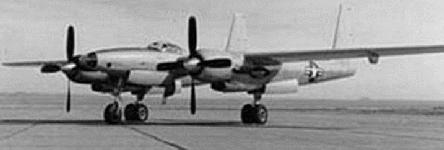




Prior to the the XF-11 and the XF-12, aircraft that had been designed for other missions were modified to perform as photo reconnaissance planes – and the results were always a compromise. During World War II, the F-4 and F-5 (modifications of the well-known Lockheed P-38 Lightning) were used to perform most of these missions.
After flying a tour in Africa in F-5s, Col. Elliot Roosevelt, son of the late president, believed that aircraft must be designed around their specific mission requirements. He outlined Army Air Force requirements and presented his ideas to the commanders at Wright Field (now Wright-Patterson Air Force Base). There he found advocates who were already trying to obtain funding to build a true photographic aircraft.
Roosevelt’s recommendations led to the development of the XF-11 (later XR-11) and its competitor, the XF-12 (later XR-12) aircraft.
Roosevelt had heard rumors of the D-2, a secretly-designed project developed by well-known millionaire Howard Hughes It was listed as a bomber, but was unsuited for the role. Reconnaissance suited the plane much better. Hughes had secretly developed the D-2 in a hangar built on Harpers Dry Lake, near Muroc Dry Lake (near present-day Edwards Air Force Base). In spite of the tight security, Col. Elliot was permitted to see the aircraft during its short life. He was so impressed that he recommended production of the aircraft to Wright Field’s procurement branch. While his recommendation was under heated discussion, the one-and-only Hughes D-2 was destroyed when lightning struck the D-2 hangar.
Despite its early destruction, the design interested Col. Roosevelt and he recommended the aircraft be ordered as a photo-reconnaissance aircraft. The D-2 had first flown on June 20, 1943, and is only known to have made two flights. Aileron difficulties caused a major redesign. The Wright Field engineers were highly skeptical of the Duramold (resin-impregnated plywood) product used to construct the D-2 and insisted the aircraft be built of metal. They further insisted that the power plants be the new massive Pratt & Whitney R4360 ("corncob"). These requirements led to an entirely new larger and heavier design, although the aircraft would still resemble the D-2.
Agreements were reached at Wright Field and contract proposals were let for two experimental XF-11s and 98 production F-11s. Hughes planned for the XF-11’s two engines to be equipped with contra-rotating propellers which were installed on the first prototype.
On July 7, 1946, Hughes flew the first prototype of the XF-11. This flight ended in disaster and nearly claimed his life. The starboard aft propeller had slammed into reverse, sending his plane into an uncontrollable yaw which sent him spiraling to the ground. From his hospital bed, he ordered the second prototype aircraft be equipped with a single propeller installation. Hughes made the first flight on the second prototype on April 5, 1947. This time the test flight went off without a hitch.
The XF-11 went to Eglin Field, Fla., (now Eglin Air Force Base) to be tested, however the Air Force canceled the program in favor of utilizing the much more economical Boeing RB-50s to meet the long-range photo-reconnaissance requirement. The XR-11 was a remarkably stable aircraft, and at high speeds lateral control was excellent – but it left a great deal to be desired at low speeds. The aircraft had a remarkably clean, low drag design with its long, straight wing looking similar to that of the Lockheed U-2, designed a decade later.

